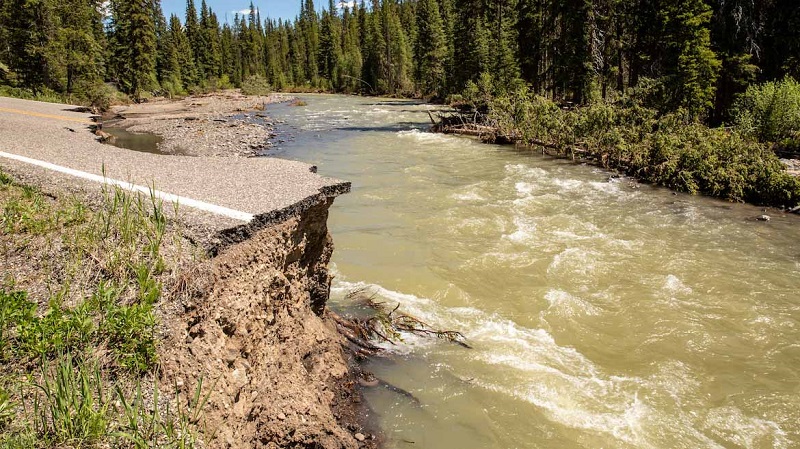Yellowstone National Park, Montana – In June 2022, Yellowstone National Park had unprecedented floods, which is currently being repaired. Even while there is a lot that is new, there is still much work to be done to recover what was lost.
The incredible force of the flood waters that stormed through Yellowstone was depicted in a park ranger’s film taken in June of last year. In the brief video, which was made public by the Park Service, you can witness a wall of murky water sweeping down the Lamar River topple 50-foot-tall trees in a matter of seconds, shoot water jets into the air, and rip large chunks of the river bank off.
Just a short distance off the north entry road, you can still see an example of the catastrophe. Only a quarter of a mile separates it from the ancient, now-abandoned Gardiner Canyon Road. The pavement along the Gardiner River drops away shortly after crossing a parking lot because it was eroded by the water’s force in June. The original Gardiner Canyon route has been replaced by a modern road that snakes up to Mammoth while providing tight curves and breathtaking views.
In an interview with MTN News, Park Superintendent Cam Sholly said, “We made the best of one of the worst possible situations.
“A park that’s reopened on the north end, communities that had a crushing impact from the flood last summer, Gardiner, Silver Gate, and Cooke City especially, reconnected,” he said, listing the rehabilitation efforts in the past year.
The northeast entry road has been reconstructed in large part, while a portion of it is still under development.
The Lamar Canyon Road, according to Sholly, “continues to experience erosion from the river below. Next Monday, a contractor will start blasting to get the road installed.
Marsha Dolan of Maysville, Missouri, observed an eagle nest holding a baby bird just a few miles east of the heavy machinery working in the canyon. She turned away from her spotting scope and remarked, “I think they’ve done a tremendous job of fixing this so people can still come.”
Sholly explained that working wasn’t simple. We set really ambitious goals last year, and if we hadn’t achieved them, we would still be in a closed position, he claimed.
A little further along the Lamar, there is new pavement installed on a hillside. The road had to be moved away from the eroded river border, therefore a hillside had to be pushed back. That slope had recently been occupied by large machinery last fall as it raced to prevent the arrival of winter snow. The labor is now complete, and the freshly planted ground is just waiting for the grass to emerge.
“The amount of work that has gone on since last July to possibly October is just unbelievable,” said Marsha Dolan.
Of course, there’s also the brand-new route that runs between Gardiner and Mammoth and offers expansive views. Because of the lengthy and winding nature of the trip, some people find it challenging to drive.
Upon hearing it, Sholly displays some unusual annoyance. For those who don’t like it, I can assure you that they prefer it to have no road.
There are occasionally lengthy queues at the construction zones in the northeastern portion of Yellowstone, where that building work is still underway. Sholly claimed that despite this, few people had complained.
Marsha’s husband, Gary Dolan, stated that he didn’t mind waiting to enter the Lamar Valley. We’d be happy to do that just for the opportunity, he replied. All of this is preferable to them shutting it down entirely and preventing us from visiting this year.
According to Sholly, the park is working to accommodate tourists. “[We’re] trying to minimize those impacts on visitors to the best of our ability, but, you know, this park won’t fix itself and we’ve got to, that Lamar Canyon project has got to get done quickly,” he continued. That needs to be pushed in, please.
Up through the end of June, there are construction delays on the Gardiner River right outside Mammoth. Additionally, in the Lamar Canyon and on the Yellowstone River Bridge to the east of Roosevelt Junction. A sewage treatment system for Mammoth is expected to be completed soon, allowing the town’s hotel and eateries to reopen.
The inability to run the large hotel or restaurants in Mammoth caused Mike Keller, General Manager of Yellowstone National Park Lodges, to suffer throughout the previous summer, fall, and winter seasons, as well as the current spring season. This is due to the fact that the road and the sewer system that transported wastewater from Mammoth to a treatment facility in Gardiner were both destroyed by the storm. He looked happier as he spoke about the restoration effort and remarked, “To think we’re doing this only one year after the historic flooding events of last year, is nothing short of amazing.”
“Everyone who played a part, and that includes the public that supported us, really should feel good about where we are,” added Sholly.
Regarding how tourists are responding to all the improvements, Keller spoke. “Honestly, a lot of amazement over the road from Gardner to Mammoth,” he admitted. That certainly brings up a lot of different experiences. Most of the summer last year saw the North entrance blocked. Then, they did reopen in October of last year at the very tail end of October, but winter visitation is incredibly low in comparison to summer visitation, which is very robust. People arriving on that road and being at a high position, the various perspectives, and the expansive beauty offered by the route have drawn a lot of compliments. The same applies to those traveling in the direction of Cook City, where the road washed out of Trot Lake and where there was a substantial washout along Sotheby Creek, as well as the local recovery efforts. You might even identify some of the new roads and the new alignments that have been set up for the average visitor for many people. They did such a terrific job of, sort of, just rebuilding the road while preserving the area’s natural integrity.
He also expressed optimism that the construction of a temporary treatment facility in Mammoth would soon be finished, enabling him to restore the hotel and restaurants by the end of June so that the concessionaire, Xanterra, could save this summer’s season.
Some things have survived in spite of the extensive damage and road repairs. A sizable piece of the petrified tree can be seen on the south side of the road, just east of the Trout Lake trail parking area. It is resting only a few feet off the road and is vibrantly colored in shades of orange, brown, and cream.
Sholly claimed that he dislikes thinking in terms of legacy. He did, however, have some suggestions for how to deal with the flooding in June 2022. “Look at how everyone came together, like I said, the teamwork from Washington to the states, counties, and communities, the team here in Yellowstone, Federal Highways, the contractors, and good weather,” he remarked. A lot of things came together for us. Since I began working here in 1990, I haven’t noticed. I’ve had a variety of jobs all throughout the nation. I haven’t witnessed a large-scale incident, and there is hardly any bureaucracy. Everyone recognized the value of working together. Everyone was aware that if we didn’t finish the work by the time the fall arrived, it would have a big impact on everyone’s lives here for the coming winter and summer.
In total, it will take many years and close to a billion dollars to repair all the harm caused by the flooding last year. But it now appears that the construction will be finished, and the roads will be more resilient to future floods and other natural disasters.



